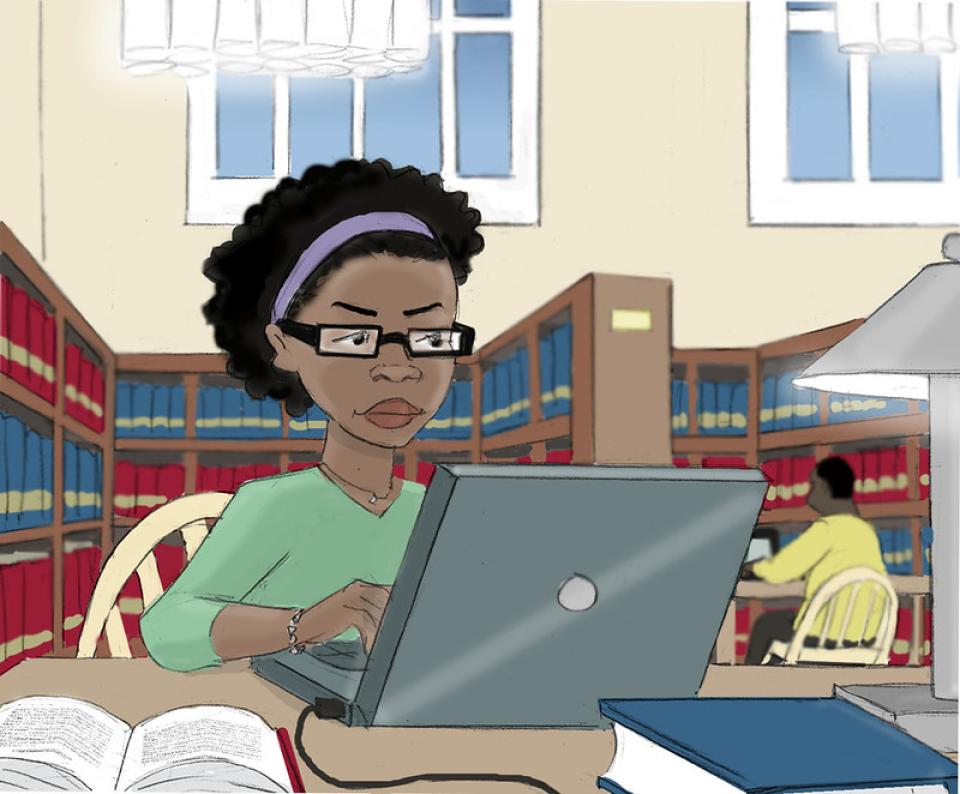
Image description: Illustration of person looking at computer in library. Image source: CALI under CC license Non-commercial Attribution ShareAlike
We are living in a troubled world which at any given time is grappling against some sort of calamity. For instance, while climate change, wildfires and consequently animal species extinction are still dominating the global agenda in some circles, there is a mounting conversation about the outbreak of the novel Coronavirus (COVID-19), as it has literally changed the trajectory of predictable global trends.
COVID-19 has affected everything around us, including our social, economic and political lifestyle. Depending on one’s perspective, COVID-19 has affected each region, country and community differently.
For any typical African community and Zambia in particular, the pandemic has come with its own unique challenges. Far away from the realities of life in the Zambian urban communities, life has been affected differently in the peripheries: deep in the outskirt communities and for a girl child, the challenges faced are much more desperate, especially when it comes to accessing the internet for e-learning purposes and access to other information online.
The Zambian context
Just like many governments across the world, Zambia has effected a series of preventive measures against COVID-19, including the restriction of social gatherings and the closure of schools. This means that unlike well-established private learning institutions that have the infrastructure and the capacity to conduct e-learning lessons almost all the time, most public institutions do not have such facilities. As such, this has created a serious gap in access to education. Recently, the United Nations Children Emergency Fund (UNICEF) projected that around 1.6 billion children and young people around the world are unable to attend schools in person. This is according to a report done by Jason Miks and John McIlwaine (2020) - Keeping the world’s children learning through COVID-19.
Recently, the United Nations Children Emergency Fund (UNICEF) projected that around 1.6 billion children and young people around the world are unable to attend schools in person.
UNICEF also gave examples of how virtual learning initiatives were fairing in countries such as Ukraine, Syria, North Macedonia and many other countries across Europe. Although Zambia is not discussed in the report, it can be readily assumed that Zambia’s education system has been negatively affected by COVID-19.
That brings me to reflect on the plight of a Zambian girl child during this trying moment. The challenges relating to a lack of access to education and the internet are much more prevalent in rural areas, where the closure of schools means no access to education and no internet for e-learning. The return of a girl child back to her home after the closure of schools meant no access to education, and, according to UNICEF research, includes domestic chores and exposure to illicit activities, including forced marriages, illicit sex and consequently teenage pregnancies. Of course, while there have been interventions to introduce virtual learning, this is a relatively new phenomenon in Zambia that is not widely embraced due to numerous challenges. For instance, according to an article done by Tech Trends (2020) MTN Zambia provides free access for university e-learning platforms. MTN partnered with various institutions of learning in Zambia to ensure that students can keep up to date with their studies during the period of COVID-19, without worrying about data costs or extra charges. In addition, according to an article Tech Trends (2020) Zamtel launches e-Learning and Smart Revision portal, an indigenous Mobile Telecommunications provider, Zamtel also partnered with the Examination Council of Zambia to launch an interactive e-learning platform to ensure continued learning. Other than that, the Ministry of General Education also announced the launch of a dedicated educational television channel.
The need for digital transformation in Zambia
Notwithstanding the initiatives undertaken, there remain many gaps in Zambia’s digital transformation that have not yet been bridged. As such, initiatives such as those mentioned above are enjoyed by a select few, with rural areas being cut off from this. This divide is largely due to a lack of infrastructure and ICT tools in rural areas. Moreover, internet penetration in Zambia still remains low, especially in rural areas.
In as much as Zambia could be a keen subscriber to the African Declaration on Internet Rights and Freedoms, that vision has not been fully actualized. Of particular relevance, principle 2 of the Declaration provides that access to the internet should be available and affordable to all persons in Africa without discrimination on any ground. This is because, as explained in the Declaration, access to the internet plays a vital role in the full realisation of human development, and facilitates the exercise and enjoyment of a number of human rights and freedoms, including the right to freedom of expression and information and the right to education. However, in Zambia, the government is not compelled to provide the devices needed to access the internet. For those who cannot afford this, particularly in rural parts of the country, they inevitably lag behind in learning, which denies them their right to access information and hinders the ability to have their right to education actualised.
Further, principle 13 of the Declaration states that: “Efforts to increase access should recognize and redress existing gender inequalities.” In an attempt to provide internet facilities, the Lusaka Mayor, Miles Sampa, had promised to deliver free internet in public places in Lusaka within 90 days upon been elected in power. However, this has not yet been effectively implemented, and in any event would only apply to the capital city, where the majority of people already have some form of use of the internet. This initiative would not serve to assist people in rural areas, where marginalised women mostly live, and people hardly own a phone.
This initiative would not serve to assist people in rural areas, where marginalised women mostly live, and people hardly own a phone.
The lack of access to the internet has also led to concerns of women and girls being misinformed, as most activities are happening online and they have no adequate means to participate or have their views heard which is making them feel left behind. This lack of access also means that they are not able to seek credible information from different sources or verify the information with which they have been provided.
Commitments from the government and the private sector
Internet and capacity building in ICTs at every level plays a vital role in the full realization and the right to education as well as freedom of expression which everyone is entitled to enjoy. It is comforting to learn that the powers that be realize this. In 2020, the Government according to TECH Trends (2020)Huawei donated 300 computers to schools across Zambia, in order to boost ICT capacities. Speaking during the handover ceremony, the President of Zambia, Edgar Chagwa Lungu said with the increased use of online learning, education facilities should access computers and other ICT materials to enhance teaching.
Those remarks definitely set the tone but unfortunately, there is a lot to be done and we still have a long way to go. For example, in 2015, the government revised the education curriculum to include ICT learning in schools. However, due to a lack of sufficient computers, some pupils were only taught theoretical knowledge and were unable to practice. As such, most of them used a computer only during the final exams, and then had to take turns using the same computers and writing their exams past midnight. as reported by Lusaka Times
This is not just a Zambian challenge but something which is widespread in many African countries currently. For instance, according to a 2019 Global System for Mobile Communications, it was revealed that the global internet penetration had passed 50% with Africa at 24%. According to the Zambia Information and Communications Technology Authority (ZICTA)) “2018 national survey on access and usage of information and communication technologies by households and individuals, it was indicated that there was a notable imbalance in the ownership of computers, observed between urban and rural areas: 14.7 per cent of households in urban areas indicated that they owned a computer, while only 2.7 per cent of households based in rural areas owned a computer.
The identified barriers to increased uptake of internet services by households included a lack of skills, the cost of devices, as well as the cost of the data or internet service.
ZICTA explained further that: “The proportion of individuals across the country with relatively more advanced ICT skills was low. The distribution of individuals according to their sex based on the type of ICT skills revealed that the majority of individuals with the identified skills were mainly male.’’
Access to ICTs is clearly proving to be a challenge for most Zambian citizens, especially women. For many women, they face the dual burden of being tasked with chores, as well as not having the required technology to access learning. These harsh realities have a huge bearing on women and girls as the many opportunities pass them by and they lag behind. Most For many Zambian girls, they opt to get married and settle for being cared for financially by their husbands, which makes them prone to different kinds of abuse as well as remain trapped in the circle of poverty.
This is worse for girl children, who are perceived as potential brides and money-spinning assets for families that want to marry them off for hefty bride prices. Their every moment at home, especially for a prolonged period of time, may culminate into either early pregnancy or abuse of forced marriage.
Previous statistics highly suggest that the coming of COVID-19 may exacerbate such kind of situations. For instance, Plan International Zambia gave a startling but true statement on the rate at which girl children who were not in school, were falling pregnant in Chadiza District on the Eastern side of Zambia. Plan International Eastern Province Regional Director, Richard Kalyata, revealed that from January to October 2019, at least 1,020 girls fell pregnant in the district.
Recommendations
A long-term plan is required to have the government provide adequate devices, such as computers or smartphones, which one needs if they are to access the internet. But as things stand, cross-sections of communities, such as children in rural areas, remain disadvantaged. Their poor backgrounds prevent them from self-procuring such devices, which impacts on the realisation of their rights of access to information and education. Furthermore, they should also put in place an accountability process where they can monitor that its indeed the pupils who are using these computers, and not teachers taking them home. They should also introduce tech clubs in various rural communities so that even the most disadvantaged girls can have an opportunity to learn tech skills.
Furthermore, they should also put in place an accountability process where they can monitor that its indeed the pupils who are using these computers, and not teachers taking them home.
Conclusion
It is apparent that e-learning is not inclusive for a nation like Zambia. While other means, such as educational programs on radio, can be useful during this pandemic, the government should still increase their efforts in finding ways to make it possible for its citizens to acquire skills in ICT. This could include, for instance, the provision of infrastructure that supports modern technology and measures to ensure that devices are sold at lower, more affordable prices. Any measures implemented should have a particular focus on bridging the digital divide – both as it stands between men and women, as well as between urban and rural areas – and should put in place deliberate programs that can support girls in rural areas to acquire such skills.
- 4500 views






Add new comment